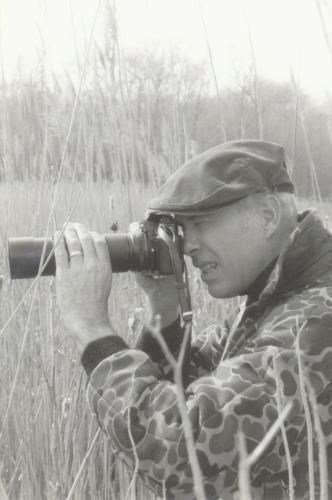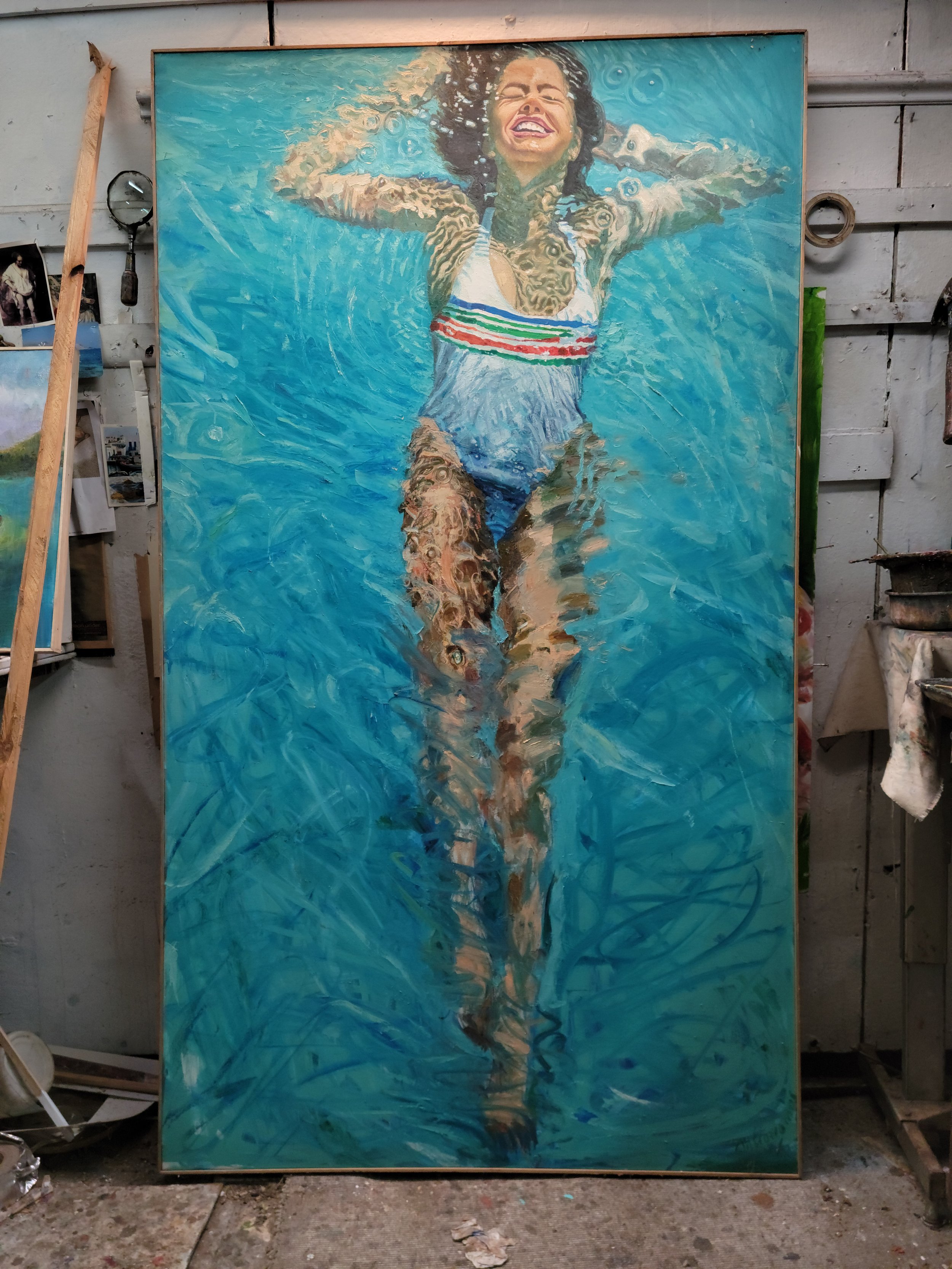Baltimore Legends
Interview by Katie Aiken Ritter
It was the era of American Pie: a generation caught between Buddy Holly and Viet Nam, between the husband-and-wife twin beds of television’s Dick Van Dyke against the Pill and the free love of Woodstock, between Haight Ashbury, Peter Max, and …well, Bawlmer, hon.
In an epic feat of collaboration, artists and Manor Mill Gallery curator Lynne Jones has brought together the work of thirty Baltimore legends: hardworking artists who inherited the legacy of those who came before them, and who in turn shaped the arts scene in Baltimore for years to come.
Some were free spirits and firebrands:
“Bob Hieronimus custom-painted a van for a band going to Woodstock…then he traveled with Janis Joplin, Jimi Hendrix, the Doors…”
“Light” the Woodstock Bus by Bob Hieronimus
“James Voshell created hundreds of paintings and murals of everyday Baltimore, mostly celebrating his beloved neighbors who were people of color—old men playing checkers, children playing, women talking, street-arabs selling produce…and one infamous painting of Baltimore’s “The Block,” home to strip clubs and sex workers. Jim’s depiction of ADULT MOVIES was deemed too obscene for an exhibit at the Morris Mechanic Theater…and when ADULT MOVIES was removed, all of the other artists in the exhibit took their paintings down too. It caused a furor…”
“Just like Glenn Walker! Glenn won prizes from The Corcoran, the BMA, everywhere—but he also had an “obscene” painting removed from a show, and all the artists walked out in solidarity…”
Other artists were more of the ‘establishment’ type:
“John Bannon, can’t forget him… He painted commissioned portraits of Pope John XXII, a US Chief of Staff, senators, congressmen, judges…”
Lynne is talking with fellow artist Carol Lee Thompson, who has been an invaluable partner in pulling together Lynne’s vision for this once-in-a-lifetime exhibit. Their words come in torrents, spilling over one another in their joy at sharing stories of the artists who were foundational in shaping their own love of painting.
“I was a young art student at Hereford High, and our teacher Barry Hamilton took us to Baltimore,” Lynne says. “It was ‘the big city’ to us. We went to Joe Sheppard’s studio, and I knew right then and there that I wanted to live in Baltimore and be a part of the arts scene.
“By 1980, I had my own gallery and frame shop in Towson, and later helped run the Phoenix Chase Gallery. I got to meet many artists and help sell their work. Much of who I was, who I am, is because of these women and men. All these years, I’ve wanted to do a show like this, to pay them back for what they gave.”
Some of the painters embraced the evolving abstractions of the 60’s, but others stood in direct opposition. One group named The Six Realists received national acclaim for what was then a defiant stand for traditional art.
As Carol explains, I’m stunned by the legacy she describes.
“You can’t talk about Baltimore art in the 60’s and 70’s without the Schuler School. It started with Jacques Maroger, who came to Baltimore’s Maryland Institute [now MICA] in 1939 because of World War II from Paris. Maroger was director of the Laboratory of the Louvre, and his life goal was to rediscover the techniques of the Old Masters. His student Ann Didusch had fallen in love with and married fellow student Hans Schuler. As MICA leaned into the modern era, the Schulers heeded Maroger’s suggestion to start their own atelier, with him at the helm.”
Hans’ own father, a renowned sculptor. Maroger’s deep expertise in painting methodology. Artist Ann, honored in the Women Artists Museum in DC, whose father and uncle were both renowned medical illustrators for Johns Hopkins…and whose grandfather had created a desk for the Pope in the Vatican, and the staircase of the Library of Congress.
Together, this talented group launched The Schuler School in 1959, the oldest still-in-use sculpture studio on the east coast.
The Schuler School of Fine Arts
“Will Wilson [a Schuler graduate] did album covers for Michael Jackson…commissions for Malcolm Forbes…”
“We don’t have any of Nate Gibbs’s work [an artist of color]. Alex Cooper did a huge sale of his works that netted over $70K…”
Likewise, one cannot tell the story of this show without those of the two women here today, who each have kept their share of the legacy alive. As Carol studied under the Schulers, she became best friends with Ann Didush Schuler, forty years her senior, and then worked as a longtime teacher for the School. “They were our heroes,” she begins again.
Work by Carol Lee Thompson
Lynne wholeheartedly agrees. “They still are. Barbara Marcus founded THE FACE OF COURAGE exhibit…She, husband Michael Economos, and fellow MICA instructor Nancy Hagin undertook painting sixty portraits of New York firefighters who died on 9/11. The exhibit traveled the US for years and was then gifted to the families who had lost those loved ones when the Twin Towers fell.”
Names of artists fly fast and furious:
“We’d love to have some of Doug Hoffman’s pieces, but he’s under contract with agents in New York and London…”
“Rob Seyffert comes from three generations of artists…he’s still teaching in NYC…Ron Russell beautifully captured his love of baseball…Steve Waugh, one of the most sensitive portrait painters I’ve known…”
White Marsh Nottingham Farm by Robert Seyffert
Other names come up. Some memories bring smiles, and others, sadness.
They speak of how Earl Hoffman endured a long struggle with mental illness. Barbara Marcus Economos died while FACES toured, far too young at only 50 years old. Her husband Michael, who for years took a train to New York twice weekly so he could teach in NYC while also at MICA, died in 2021. David T. Turnbaugh, thrilled about this show, had passed only days beforehand.
David Turnbaugh (1937-2023)
“I cut my artistic baby teeth going to openings with these legendary artists in their heyday,” Lynne relates. “We’d sit and drink and talk and gossip long into the night—earlier forays into weed and psilocybin had yielded to wine and National Bohemian beer—and I truly loved listening to them. These are serious working artists with lifelong dedication to their craft. They’ve given decades to their work and to the art community. It’s heartbreaking that so many of the lions of those former days now feel forgotten.”
She wipes a tear, and—typical of Lynne—makes a joke about something that deeply troubles her.
“They’re dying so fast. They’ve got one foot in the grave, and the other on a banana peel. What this show means to them”—now tears flow unhindered—“They’re in their 80’s and 90’s, and they never thought it would happen again. It’s so magnificently unexpected. I’m beyond grateful that I can bring a ray of light to them, the wonderful excitement of decades before; the thrill of an opening, a show.”
She pauses. “It’s a gift back to the community who gave so much to me.”
Carol nods, her own eyes sparkling. The two of them turn to discussing how to hang the many works in the gallery—ninety pieces is a beast of a show—and are soon lost in conversation again.
As I make my way through the waiting gallery, American Pie comes to mind: the album cover of Don McLean, his thumb embellished with the Stars and Stripes, and I can almost catch the echo of his famous song.
“A long, long time ago, I can still remember how that music used to make me smile…and I knew if I had my chance, I could make those people dance, and maybe they’d be happy for a while. Drove my Chevy to…”
What…you thought I was going to say I drove to the levee, where they were drinking whisky and rye?
Not so fast: this is Baltimore, after all. Life marches on and we all get old, but here we do it with a Charm City twang: fingertips smoothing brown paper over an outdoors table, and the smell of steamed crabs and Old Bay drifting on the salt tang of coastal air, the refreshing taste of a crisp, cold Natty Boh in the endless summer of an artist’s imagination.
Swimmer Series 1 by Michael Economos
And not just any artist: a 60’s-era artist from Bawlmer, hon. Slide over and hand me a mallet.
If you’re looking for something to do this weekend, BALTIMORE LEGENDS: ARTISTS OF THE 60’S AND 70’S will be at Manor Mill’s fine arts gallery from March 2 through March 26.
An opening reception is March 4, 4-8 pm. The public is invited. Carpooling is recommended as parking is limited.
Lynne Jones—art conservator, estate art manager, Mill gallery curator, and artist whose works of nature contain elements of magical realism—partnered in producing a comprehensive book of James Voshell’s life and works.
Carol Lee Thompson’s dedication to the atelier’s artists led to her own career as a celebrated equine artist, whose paintings of east-coast foxhunters, western cowboys, and tribal figures are represented in major galleries. Carol teaches at Zoll Studios in Towson.
By Katie Aiken Ritter
Instagram: @KatieRitterVikingWriter
Contact
gallery@manor-mill.com
Instagram: @manormillgallery







